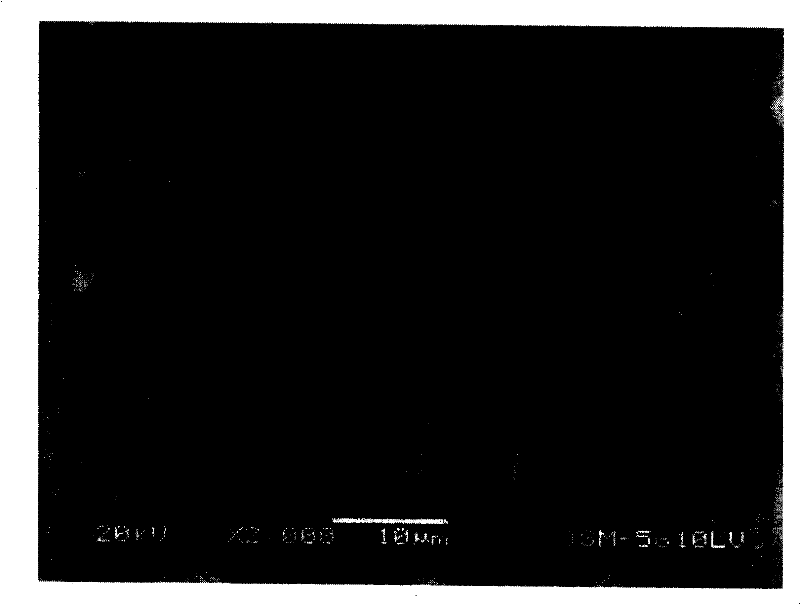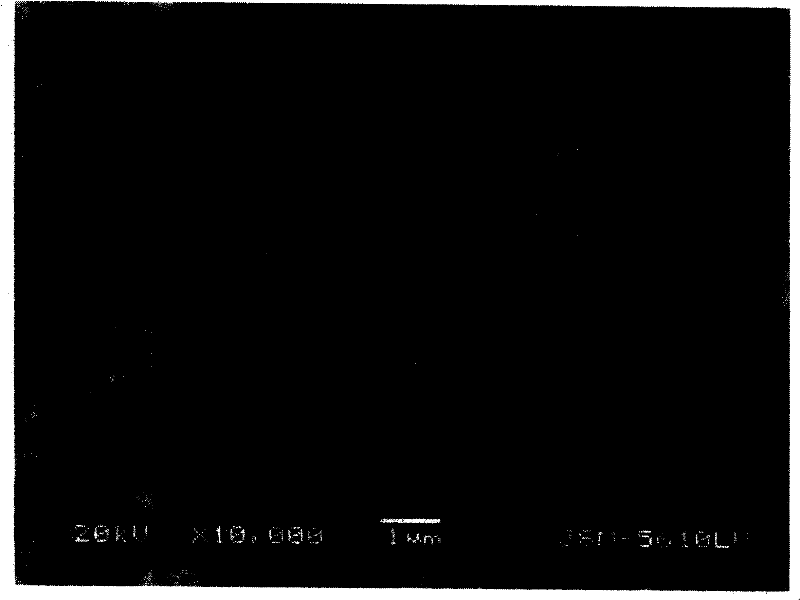Silicon-containing composite material and its preparation method and application
A silicon composite material and silicon particle technology, applied in the direction of fibrous fillers, dyed polymer organic compounds, etc., can solve the problems of destroying the structure of graphite particles and affecting the electrochemical performance of composite materials, achieving uniform structure, excellent electrical conductivity, The effect of simple and easy process
- Summary
- Abstract
- Description
- Claims
- Application Information
AI Technical Summary
Problems solved by technology
Method used
Image
Examples
preparation example Construction
[0026] According to the preparation method of the silicon-containing composite material provided by the present invention, in order to make the polymerization reaction more uniform and to make the coating layer more uniformly cover the surface of the silicon particles, the method of making the conductive polymer coated on the surface of the silicon particles is included in In the presence of inorganic dopants and silicon particles, the solution of the organic polymer precursor is subjected to polymerization reaction under polymerization reaction conditions. The solution of the organic polymer precursor contains the organic polymer precursor and a solvent, and the concentration of the organic polymer precursor in the solution may be 0.5-25% by weight, preferably 1-10% by weight. The organic polymer precursor is a monomer substance capable of reacting with an inorganic dopant to form a conductive polymer after polymerization. The organic polymer precursor may be, for example, on...
Embodiment 1
[0039] This example is used to illustrate the silicon-containing composite material provided by the present invention and its preparation method.
[0040] Add 0.5 grams of silicon particles (the average particle diameter is 20-50 nanometers, purchased from Zhongzhang International Co., Ltd.) and 0.5 grams of polyvinyl alcohol into 100 milliliters of hydrochloric acid solution with a concentration of 1 mol / liter, and magnetically stir the silicon particles to disperse evenly . Then 0.5 g of aniline was added at room temperature and magnetic stirring was continued for 30 minutes. Then 50 milliliters of 1 mol / liter hydrochloric acid solution containing 1.32 grams of ammonium persulfate was added dropwise to the above mixed solution, and the addition was completed in 1 hour. After the dropwise addition was complete, stirring was continued for 3 hours. Then the mixed solution was filtered, washed, and dried at 80° C. to obtain the silicon-containing composite material S1 provided...
Embodiment 2
[0042] This example is used to illustrate the silicon-containing composite material provided by the present invention and its preparation method.
[0043] 0.5 grams of silicon particles (average particle diameter D 50 0.45 μm) and 0.5 g of polyvinyl alcohol were added to 100 ml of lithium chloride solution with a concentration of 1 mol / L, and magnetically stirred to disperse the silicon particles evenly. Then 2.5 g of aniline was added and magnetic stirring was continued for 30 minutes. Then 50 milliliters of 1 mol / liter hydrochloric acid solution containing 1.32 grams of ammonium persulfate was added dropwise to the above mixed solution, and the addition was completed in 1 hour. After the dropwise addition was complete, stirring was continued for 3 hours. Then the mixture was filtered, washed, and dried at 80° C. to obtain the silicon-containing composite material S2 provided by the present invention. Measure the average particle diameter D with X100 particle size analyzer...
PUM
| Property | Measurement | Unit |
|---|---|---|
| diameter | aaaaa | aaaaa |
| particle diameter | aaaaa | aaaaa |
| thickness | aaaaa | aaaaa |
Abstract
Description
Claims
Application Information
 Login to View More
Login to View More - R&D
- Intellectual Property
- Life Sciences
- Materials
- Tech Scout
- Unparalleled Data Quality
- Higher Quality Content
- 60% Fewer Hallucinations
Browse by: Latest US Patents, China's latest patents, Technical Efficacy Thesaurus, Application Domain, Technology Topic, Popular Technical Reports.
© 2025 PatSnap. All rights reserved.Legal|Privacy policy|Modern Slavery Act Transparency Statement|Sitemap|About US| Contact US: help@patsnap.com



